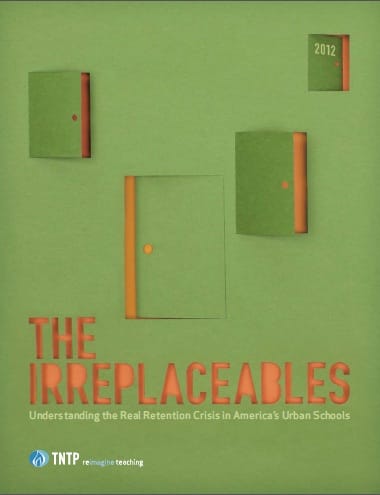 Erudite yet common-sensical, this latest from TNTP (formerly The New Teacher Project) explains in great detail why we’re losing stellars teachers from our urban cores—and how to remedy this problem. Per TNTP, we’re failing to keep the best-and-brightest classroom instructors (dubbed “Irreplaceables” and defined as districts’ top 20 percent by value-added metrics). Their departures create deep and difficult-to-fill human-capital holes. To quote the authors: “When an Irreplaceable leaves a low-performing school, it can take eleven hires to find one teacher of comparable quality.” For an average school, one in six hires will be of equal quality. The report analyzed data from four large urban districts and found that schools retain their best and worst teachers at similar rates. From year to year, low-performers (those in the bottom quintile) are just 4 percentage points more likely to leave teaching than those in the top quintile. Extrapolated, this means that each year, 10,000 Irreplaceables flee the nation’s fifty largest school districts, or leave teaching altogether. TNTP places the onus for this largely on school leaders (who have an equally aggressive departure rate from urban schools, mind you)—though district heads, union bosses, and state policymakers are also held to account (for creating or allowing policies that incentivize principals to retain the status quo). Overall, TNTP found that less than 30 percent of Irreplaceables leave their post for reasons beyond their school’s control, meaning that principals strongly influence the decisions of 70 percent. Or could. Two-thirds of high-performers reported that no one ever encouraged them to return for another year, an example of how little principals are targeting retention of these strong educators. TNTP offers a bold suite of reforms to correct this trend, tackling everything from principal quality to teacher pay to tenure. Supes and school leaders: Study up.
Erudite yet common-sensical, this latest from TNTP (formerly The New Teacher Project) explains in great detail why we’re losing stellars teachers from our urban cores—and how to remedy this problem. Per TNTP, we’re failing to keep the best-and-brightest classroom instructors (dubbed “Irreplaceables” and defined as districts’ top 20 percent by value-added metrics). Their departures create deep and difficult-to-fill human-capital holes. To quote the authors: “When an Irreplaceable leaves a low-performing school, it can take eleven hires to find one teacher of comparable quality.” For an average school, one in six hires will be of equal quality. The report analyzed data from four large urban districts and found that schools retain their best and worst teachers at similar rates. From year to year, low-performers (those in the bottom quintile) are just 4 percentage points more likely to leave teaching than those in the top quintile. Extrapolated, this means that each year, 10,000 Irreplaceables flee the nation’s fifty largest school districts, or leave teaching altogether. TNTP places the onus for this largely on school leaders (who have an equally aggressive departure rate from urban schools, mind you)—though district heads, union bosses, and state policymakers are also held to account (for creating or allowing policies that incentivize principals to retain the status quo). Overall, TNTP found that less than 30 percent of Irreplaceables leave their post for reasons beyond their school’s control, meaning that principals strongly influence the decisions of 70 percent. Or could. Two-thirds of high-performers reported that no one ever encouraged them to return for another year, an example of how little principals are targeting retention of these strong educators. TNTP offers a bold suite of reforms to correct this trend, tackling everything from principal quality to teacher pay to tenure. Supes and school leaders: Study up.
SOURCE: The New Teacher Project (TNTP), The Irreplaceables: Understanding the Real Retention Crisis in America’s Urban Schools (Brooklyn, NY: TNTP, July 2012).
